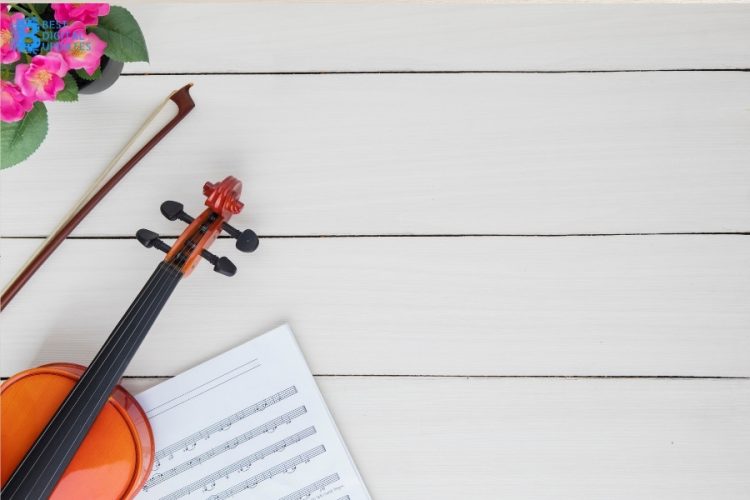Indian classical music comes from the Indian subcontinent. It comprises two major traditions. One is North Indian classical music tradition called Hindustani, and the other is the Carnatic tradition. Western classical music is rooted in the traditions of western culture, specifically European classical music. It originated roughly around the 11th century.
They both are classical, but when we dig deeper, we find that there are significant differences between them. Let us have a look and understand them in detail:
Notation system:
Table of Contents
Musical notation is a system to represent music played with instruments or sung by the human voice, visually, using written, printed, or otherwise-produced symbols, including notation for durations of the absence of sound such as rests. Simply put, it is a written version of any song or music composition. People use many languages all over the world. So, there are so many different music styles as well as notation systems. The staff notation system is the most popular system. It comes from European classical music. Western music follows the staff notation. However, Indian classical music has its own notation systems.
Melody and harmony:
A Melody is a single musical phrase, but harmony is playing or singing more than one musical piece at a time. Indian classical music is based on melody, picking notes while maintaining the sur and the taal. Western classical music is a little different, it uses harmony extensively.
Use of falsetto:
Falsetto comes from the Italian word ‘Falso’, which means false. When a singer sings high notes beyond their vocal range or capacity in Western music, they use the falsetto technique. Whereas in Indian music vocalist almost always sings with an open chest voice.
Vocal range:
In Indian classical music, the vocal range is based on three Saptaks, called Mandra (low), Madhya (mid), and Taar (high). In contrast, there is no Saptak theory for vocal range in Western classical music. There are six types of vocal range in Western music, Bass, Baritone, Tenor, Alto, Mezzo-Soprano, Soprano. Bass, Baritone, and Tenor are male vocal ranges while Alto, Mezzo-Soprano, Soprano are generally female vocal ranges.
Vibrato:
Vibrato comes from the Italian word ‘vibrare’. When we sing freely, it creates a vocal vibration which is normal. But vibrato is a technique used in Western classical music where vocal cords get vibrated more than usual. In Indian classical music, there is no use of Vibrato. They use straighter notes.
Stage performance:
As Indian classical music is melody-centric, the artists use minimal instruments in their stage performance. There is only one leading artist and two or three accompanying artists on stage while performing. In Western classical music, we see an orchestra setting while performing. As it is based in harmony, Western music uses many instruments and vocal artists for a stage performance.
Improvisation:
In Indian classical music, accompanying artists do not perform freely, they perform according to the leading artist. That is why the prominent artist gets the opportunity to improvise their performance. Western music is all about teamwork. All accompanying musicians are as influential as the leading artist. All musicians play and sing their music pieces and create harmony. So basically, they all have to pre-plan or pre-arrange their performance before to avoid mistakes. So, the scope of instant improvisation on stage is restricted in western classical music.
Taal or Rhythm:
In Indian classical music, Rhythm is formed as taal. There are a variety of taals or rhythms in Indian music; six beats, seven beats, 8, 10, 12, 14, or 16 beats for example. In western classical music, there is a time signature. Taal is based on the cycle concept, but time signature is based on the linear concept. There are many time signatures such as 2/4, 3/4, 4/4, 6/8 etc.
Spirituality and nature:
Indian classical music has a more defined connection with nature than Western classical music. The ragas have specific times of day in which they are sung. In contrast, most Western classical music does not carry such characteristics. The origin of Indian classical music is spiritual. Western classical music has roots in individual experiences, significant historical events in human history, entertainment, occasions with dance celebrations, etc.
Well, it is not a piece of cake to understand these differences and little intricacies, unless you experience and learn them practically under the right guidance.
Online singing classes with Monali Thakur
Honoured by a national film award, a Filmfare award, and many more, she is here to teach you the basics and intricacies of singing. We provide you with an exclusive opportunity to learn with her and like her through our online singing course. Do not miss this opportunity to polish your knowledge and learn under an expert’s guidance. Check our website for more information and start your journey towards becoming a professional singer.
Also, Read about how to choose the right music equipment online and many more articles on Best Digital Updates




















